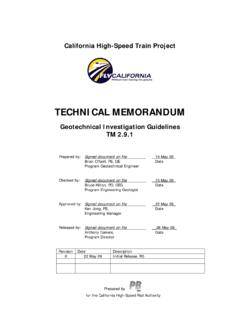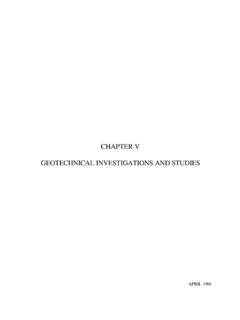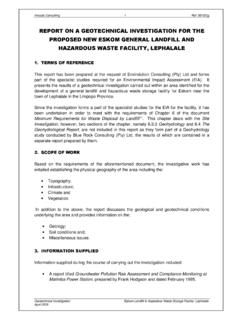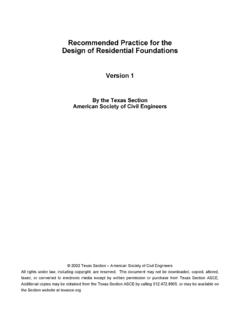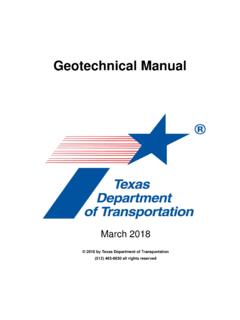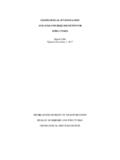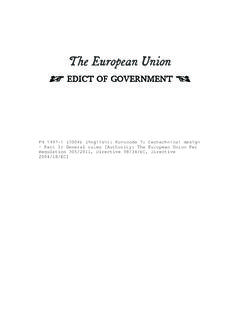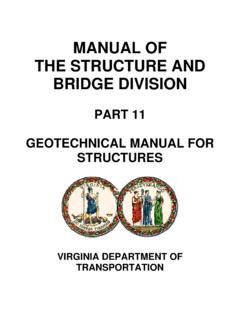Transcription of Guidelines for Evaluating Potential Surface Fault Rupture ...
1 Guidelines for Evaluating Potential Surface Fault Rupture /Land Subsidence Hazards in Nevada The Nevada Earthquake Safety Council recommends the use of the following Guidelines for Evaluating Potential Surface Fault Rupture /Land Subsidence Hazards. The Council recognizes that the governing standards are the current locally adopted codes and ordinances. The Nevada Earthquake Safety Council facilitates public input, develops consensus about seismic issues within the public and private sectors, and is the public advisory body for state seismic policy and the Nevada Earthquake Risk Reduction Program of the Division of Emergency Management. The Board of Directors of the Council, which votes on policy recommendations, has 21 members, from both southern and northern Nevada, representing business and industry; city, county, and state governments, including the Assembly and Senate; geosciences; engineering; community organizations; universities; building officials; insurance; and primary-secondary education.
2 The first version of these Guidelines was dated 30 July 1996; minor typographical errors were corrected on 24 November 1997. The Nevada Earthquake Safety Council approved this Revision 1 on 20 November 1998. Jonathan G. Price Director/State Geologist, Nevada Bureau of Mines and Geology, and Secretary, Nevada Earthquake Safety Council Guidelines for Evaluating Potential Surface Fault Rupture /Land Subsidence Hazards in Nevada (Revision 1) I. INTRODUCTION These Guidelines were prepared by a subcommittee of the Geoscience Committee on Seismic Hazard Issues at the request of the Nevada Earthquake Safety Council, which is affiliated with the Division of Emergency Management, Department of Motor Vehicles and Public Safety, Division of Special Services. Significant seismic hazards are present in Nevada.
3 With the increase in population, the evaluation of Fault Rupture and fissuring is becoming more important for land use planning and development. The intent of these Guidelines is to provide a standardized minimum level of investigation for Fault Rupture and fissuring in Nevada. They were prepared using established Guidelines for Surface Fault Rupture evaluation in California and Utah, and the current standard of practice in the greater metro Las Vegas, Reno, Sparks and Carson City areas. These Guidelines were prepared by The Association of Engineering Geologists, Great Basin Section in Reno, Nevada and the Southwestern Section in Las Vegas, Nevada in conjunction with the Nevada Bureau of Mines and Geology, the University of Nevada, Reno, other Nevada professional geological organizations and the private geological consulting community.
4 II. WHEN TO PERFORM ANALYSIS The investigation of sites for Potential Surface Rupture or hazards due to differential subsidence and fissuring shall be included in all geotechnical investigations. III. DESCRIPTION OF THE INVESTIGATION A. INTRODUCTION A competent professional should perform geologic investigations. Because of the complexity of this analysis, the competent professional performing each investigation must determine what is appropriate and necessary to obtain the highest quality information. The most useful technique at one site may be inappropriate for another site. B. RESEARCH Review of the region's seismic history, based on existing maps and technical literature. 1. Specific to Fault Rupture Hazard: a. Historic earthquakes, epicenter locations, and magnitudes in the vicinity of the site.
5 B. Location of Fault traces that may affect the site, including maps of faults and a discussion of the tectonics and other relationships of significance to the proposed construction. c. Location and chronology of other earthquake-induced features, such as settlement, landslides and liquefaction. d. Review of local groundwater data (water-level fluctuations, groundwater impediments, water quality variations, or anomalies indicating possible faults). 2. Specific to Differential Subsidence and Fissure Hazard: a. Identify and locate any faults, scarps, and fissures in the vicinity of the site. b. Review available land level lines of past ground Surface movement in the vicinity of the site, including degree of differential subsidence across nearby faults and proximity of regional subsidence bowls.
6 C. Review groundwater development in the vicinity including the location of nearby high-capacity wells. Review available well maintenance records of nearby wells for signs of possible subsidence-induced damage. d. Review of subsurface units from available well driller's logs for nearby water wells and available historic water level data from nearby wells. C. AERIAL PHOTOGRAPHS Analysis should include interpretation of aerial photographs and other remotely sensed images for Fault -related topography, vegetation, soil contrasts, and lineaments of possible Fault or fissure origin. Where possible, analysis may include low-sun-angle aerial photography and/or aerial reconnaissance. D. Surface INVESTIGATION A competent professional shall inspect the site. 1. Non-Specific: a. Mapping of Surface features, including geologic units and structures and topographic features both on and beyond the site.
7 For normal and strike-slip faults these features commonly include: Normal faults Strike-Slip Faults Over-steepened base of mountain fronts Scarps in Quaternary deposits and landforms Scarps in Quaternary deposits and landforms, and offsets in Quaternary deposits Scarps, and laterally offset streams and ridges, and offsets in Quaternary deposits Grabens in Quaternary deposits Rift valleys Faceted spurs Shutter ridges Zigzag Fault patterns Pressure ridges Wine glass canyons Sag ponds Fissures, springs, vegetation alignments Fissures, spring and vegetation alignments b. Conduct visual inspections for signs of ground movement (distress) of man-made structures on adjacent developments. Review available soils reports to determine the geotechnical conditions of sites in the area.
8 2. Specific to Fault Rupture Hazard: a. If any Quaternary age Surface Rupture is mapped or otherwise interpreted to be present on the site, the feature shall be further investigated as described below in Section III E. E. SUBSURFACE INVESTIGATION A subsurface investigation shall consist of trenching and other excavating, with appropriate logging and documentation to permit detailed and direct observation of exposed geologic units and features. 1. Non-Specific: a. This includes trenching across potentially active faults and suspicious zones to determine the following: location and recency of movement, width of disturbance, physical condition of Fault zone materials, type of displacement, geometry of Fault features, slip rate, and recurrence interval. b. Borings or test pits to collect data to evaluate depth and type of materials present, groundwater depth, and to verify Fault -plane geometry.
9 Data points should be sufficient in number and adequately spaced to permit correlations and interpretations. c. Geophysical surveys conducted to facilitate the evaluation of the types of site materials and their physical properties, ground water conditions, and Fault displacements. 2. Specific to Differential Subsidence and Fissure Hazard: a. Detailed trench logging at the site should focus on determining the location and possible causes of fissuring. Compare trenches across fissures in areas on the site and in areas where fissures are not observed at the Surface . Additional objectives should be determining the width of the fissure zones and the general geometry and depth of fissures. Analysis of trenches should help determine feasible means of site remediation. F. SPECIAL INVESTIGATIVE METHODS 1.
10 Special investigative methods may be used when conditions or critical structures demand a more intensive investigation. a. Aerial reconnaissance overflights, including special photography. b. Geodetic and strain measurements, micro-seismicity monitoring, or other monitoring techniques. c. Radiometric age analysis (C14, K-Ar), stratigraphic correlation (fossils, mineralogy), soil profile development, paleomagnetism, or other age-dating techniques to identify age of faulted or unfaulted units or surfaces . IV. SUGGESTED OUTLINE FOR Potential Surface Rupture SECTION OF GEOTECHNICAL INVESTIGATION REPORTS The following subjects should be addressed, or at least considered, in any geologic report on faults. Some of the investigative methods described herein should be carried out beyond the site being investigated.

